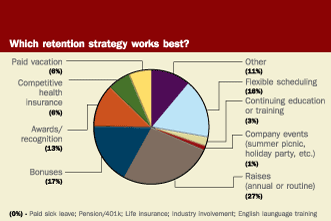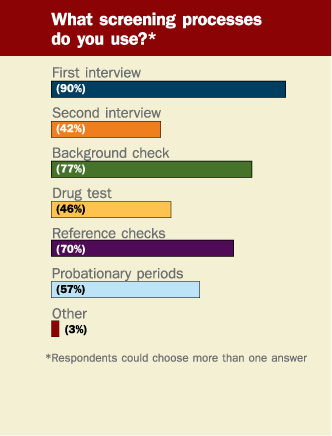So often in the cleaning business, building service contractors focus on establishing and developing value, trust and relationships with customers when seeking success in accounts. But do they have that same dedication to relationships with employees?
According to a recent Contracting Profits labor survey of BSCs, building trust and relationships with employees is just as, if not more, integral to keeping accounts than relationships with customers. BSCs that don’t have loyal, dependable and hardworking employees literally have no legs to stand on, and will crumble even if every other piece of the corporate puzzle is in place.
Turnover
Personnel loss is one of the biggest issues BSCs face on a daily basis, and it is battled by retention strategies as well as stringent hiring practices. According to the survey, however, rates are lower and more manageable than they have been in years past, when a 75 percent turnover rate was a commonly cited average. Some industry experts have claimed the rate can be as high as 400 percent, but survey respondents this time have turnover rates averaging 34 percent.
Heading into the second quarter of ’09, the subject of turnover is influenced for almost all BSCs by the recession — an inescapable factor that may be part of the reason our survey average was so low. It’s hard for BSCs to talk about business these days without bringing up the economy, which has forced many customers to cut back services and increased the value workers place on the jobs they’ve got. As a result, contractors are finding themselves with fewer job openings and more applicants.
Tom Heveron, president of Beachland Cleaning Services in Vero Beach, Fla., says his turnover is at about 21 percent and predicts the turnover rate will continue to drop as the economy heads further into a slump.
In fact, whereas turnover and retention used to be more of a concern to BSCs than their employees, it seems the tables have turned and that retaining jobs has become a particular worry for workers, he says.
“It’s just been my experience that people do not give up their jobs now. Before, people would just walk away, but now they hold onto them — they even do a better job because they’re protecting their jobs. Now, they’re taking it seriously,” Heveron says.
For a number of reasons, it seems employees are hanging onto their cleaning jobs, whether they’re part-time or full-time. BSCs that have small to medium sized customers typically employ mostly part-time workers, and they’re finding that a bad economy is advantageous from a turnover perspective because people need those jobs and the extra income they provide more than ever.
Full-time vs. part-time
BSCs who took the survey had an average of 209 employees, and averaged more part-timers than full-timers. Those BSCs who have more full-time employees have slightly lower turnover than those those who have more part-time employees.
Some contractors that have a good balance of full- and part-time positions say that full-time jobs are where the real security is.
“Part-time positions definitely turn over more,” says David Murphy, president of Supreme Maintenance Organization, Greensboro, N.C.
Demand for full-time cleaning jobs is also higher during times of high unemployment, but BSCs who have managed to add full-time positions to payroll say regardless of the economy, their turnover rates are positively affected by the addition of those positions.
Rafael Perez, owner of Houston-based Mexfil Hotel and Building Services, says turnover for his business was higher when he employed more part-time workers. He wants to continue to add full-time jobs to accounts because he sees a greater commitment to the job from workers who need full-time employment.
“I want people that are going to concentrate 100 percent on my properties,” he says. “When it’s a full-time job, they’re not going to quit it. When it’s a part-time job, they’re going to find another job. During Christmas, Thanksgiving, Fourth of July — I used to dread those holidays landing on Thursdays and Fridays. Now, if there’s a holiday on a Thursday night or Friday night I can go to sleep knowing that building is going to get cleaned. Reason being, is that this is a full-time job. People aren’t going to blow it off.”
Of course, every BSC has a different clientele and workforce; what works for some doesn’t necessarily work for others. A vast majority of Heveron’s employees are part-timers who work full-time during the day at another job and have taken a second job to supplement income. Many of them have been with the company almost a decade.
“I’ve found you normally get a better commitment from people who have been working full-time and need a part-time job to fulfill some other requirements in their lives,” Heveron says. “And if you find people like that, generally those are the people who stick around. They want to do the job, they want to do the work.”
In any industry, some turnover cannot be prevented; workers will always have personal reasons for quitting, such as finding a new job, relocation and other life changes. How much an employer can influence turnover rates is unknown, but those who are proactive feel that they do have at least some control over it.
“[I have] a lot of power,” says Matt McCasline, owner/general manager of Aspen Ridge Janitorial LLC in Tualatin, Ore. “There will always be turnover but it becomes very manageable by training and motivating employees to build careers, not just jobs.”
Every BSC has unique factors influencing turnover for full-timers and part-timers, but all agree that smart hiring and retention tactics can prevent turnover rates from climbing.
Hiring and retention
On the front end, smart hiring practices that include reference checks, thorough interviewing, criminal background checks and other screenings are a great way to bring on employees that are likely to stick around and do a good job.
As far as finding workers, word-of-mouth advertising works for most contractors, with 80 percent trusting current employees to recommend acquaintances for open positions. About half use newspaper classifieds for front-line positions; that’s where workers will look for a job as compared to online classifieds or professional networking sites. BSCs that do turn to job sites are typically looking for supervisors and managers.
Certain hiring tactics are popular with BSCs. Forty-two percent of BSCs surveyed use a second interview to screen candidates, 74 percent perform background and reference checks, and 57 percent use probationary periods. Screenings and personality assessments are also commonly used in the hiring process.
“Retention tactics are important, but I think smart hiring’s more important,” Murphy says. “I think you have to hire the right people to begin with.”
Holding onto good workers involves a different plan. Retention strategies include paid vacation and sick leave, competitive benefits, awards and recognitions, and company events, with raises being most popular at 61 percent. Survey respondents also say raises are the best retention strategy.
“Raises are important because workers like to feel like they are being rewarded for the hard work they do,” McCasline says.
Though employees have many reasons for leaving, the most common responses in our survey related to finding another better-paying job.
BSCs can combat that by paying more than the average janitorial wage in their areas, or giving raises based on merit and tenure. Wages are Perez’s number one labor concern. He starts his employees at as much as 50 cents more per hour than his competitors, which is an immediate incentive to perform well and stick with the company.
“In today’s market, I’ve got to do two things at once with half of the effort because of the economy,” Perez says. “I’ve got to keep the customer happy and at the same time I’ve got to keep the employee happy. So retention is by far our key to success.”
Money isn’t the most important strategy for all BSCs, however. Even contractors who can’t afford to pay as much as the competition or give huge raises have other options. Awards, recognition, company events and flex scheduling were popular among respondents. Not only are revenues and profit margins shrinking, but minimum and living wages are going up — not to mention the additional burgeoning expense of benefits and insurance.
The realities of the job and its wages need to be discussed during the hiring process so that front-line workers understand and accept that janitorial jobs are physically difficult and not high-paying.
“With janitorial [jobs], they will never be rich,” says David Cottle, president of ServiceMaster Professional Cleaning, Phoenix. “I think the expectations need to be addressed in the beginning.”
An average employee stays from one to 10 years, according to the survey, with 11 percent staying six months or less.
Promoting from within is a very popular retention tool, with 88 percent reporting that preference. Most owners and presidents have done front-line work themselves at some point, and having that practical knowledge of the job is something that subordinates respect.
“Unless you want to start over with a whole new crew, you promote from within,” says Robby Thrasher, owner of Custom Cleaning in Lubbock, Texas. “Respect is earned one day at a time on both sides. A stranger brought in to lead may be good, but may make unneeded changes.”
Also, a janitor-turned-supervisor presents a familiar face to customers, helping maintain that relationship of trust, he adds.
If this survey is any indication, the key to attracting the right employees and retaining them is to treat them with respect. Value-added isn’t just for customers, BSCs say — the big issues such as wages, raises and benefits are important, but it’s the little perks that help make employees’ lives a bit better.
“Our philosophy is that our employees are our internal customers,” Murphy says. “They are just as important to us as our customers and we try to treat them that way and hopefully that filters from the top down. A lot of contractors, like us, started the business from the ground up and when you’ve come from that perspective, you probably have a more thorough appreciation for your front-line employees.” 
Click & View
|

 Celebrating BSCAI's 60th Anniversary eBook
Celebrating BSCAI's 60th Anniversary eBook The Down and Dirty on Cleaning in Virus Season
The Down and Dirty on Cleaning in Virus Season How Surfactant Use is Expanding in Commercial Cleaning
How Surfactant Use is Expanding in Commercial Cleaning


